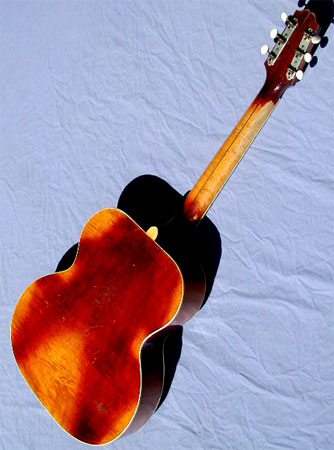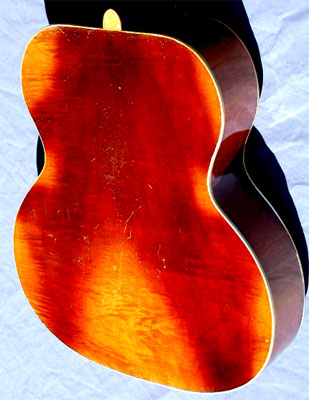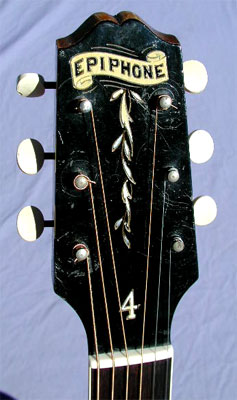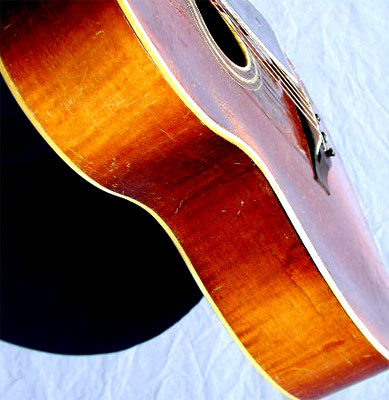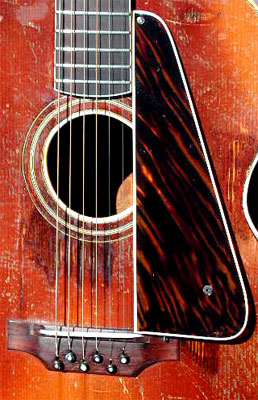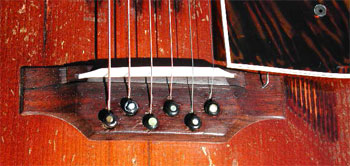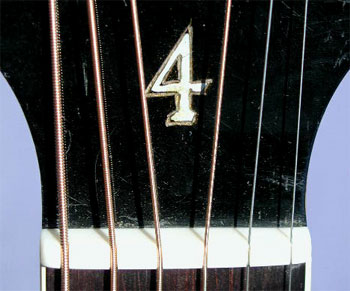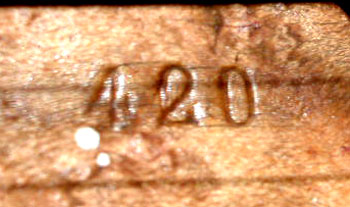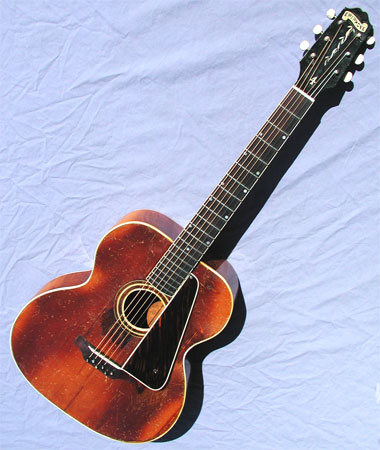
Home / Instruments /Accessories / Ordering / Tips
archtop.com
ca. 1930 Epiphone Seville S-4-A
Status: SOLD For instruments now available, please visit our Instruments page here. To be notified of examples of this model or similar instruments as they arrive, please contact [email protected]. Please be specific on which instrument(s) you're looking for, and we'll be happy to contact you as soon as they become available.
Serial #: 420, stamped inside back
Body size at lower bout: 15 3/4" Scale length: 25 1/2" Nut width: 1 3/4" Body depth: 3 1/2"
Finish: Original sunburst finish, nitrocellulose lacquer type
Materials: Hand carved solid arched spruce top; arched flamed maple back and sides; two piece maple neck with walnut centerstripe; Brazilian rosewood fingerboard; ornate celluloid peghead veneer; triple-bound body, bone nut
Hardware: Original three-on-a-plate nickel tuners; original rosewood bridge. Vintage correct bound 30's Epi tortoise pickguard.
Notes: It's always a thrill to find an instrument of a model type we've never seen before. It's quite another to find an example we've never even heard of. But here it is, an Epiphone model so rare, it's barely a footnote in the reference books. The Epiphone Seville models were a transitional design between the "Recording Series" (Models 'A' through 'E') of the late 20's, and Epi's first Masterbilt f-hole archtops of the early 30's. Numbered 1 thorugh 4, the Seville models represented a significant advance in the effort to design acoustic guitars with sufficient projection to replace the banjos of the early big band era.
Available in both 'Concert' (13 5/8"), and 'Auditorium' size (15 3/4") the guitars were the first Epis with a 14 fret neck, and the first to adopt the 25 1 /2" scale, over seven years before Gibson made the longer neck standard on their largest archtops. Another innovative features is the self-centering bridge, a rosewood retainer for the bone saddle that slides in a channel on the front of the bridge. The bridge pins are staggered in placement, and the suspended bound tortoise pickguard is held in place without a bracket, employing an ingenious retaining pin to the bridge, in a fashion similar to Gibson mandolins of the teens.
The Model 4 was the top of the line, and the most ornate of the Models 1 though 3. The unusual inverted V pattern sunburst finish is quite unlike any we've seen, and the celluloid peghead design is a unique stylistic transition between the baroque Recording Models (whose diagonal dot fingerboard inlays are borrowed here) and the later Masterbilt archtops. And then the sound: much bigger and bassier than the Gibson L-4, with more sustain than the f-hole archtops to follow, and a piercing sonority perhaps best associated with the better gypsy guitars. Make no mistake, this is no wall hanger curio. This guitar demands to be played, and played hard.
And played hard it was. The carved soundboard is deeply grooved with pickwear beneath the strings, and at the end of the pickguard near the bridge. The original finish is intact, with a few areas of spot finish over heavy wear areas, and the arched maple back shows appealing flame figure. The body is peppered with finish dings, and the top has a number of soundly repaired cracks. The suspended bound tortoise pickguard is an Epi model from the later 30's, and has been installed here in the correct fashion, with the retaining pin in the bridge. The rosewood fingerboard is wonderfully level, with recently installed fretwork in excellent condition, and fine low action.
Based on a more than a quarter century of close attention to the vintage market, it's our estimate that there cannot be more than a handful of surviving specimens of this rarest of Epi round hole guitars. An unusual opportunity to own one of the scarcest and most significant American fretted instruments ever.
Setup: The frets have been precision leveled, recrowned and polished; bridge saddle and nut adjusted; fingerboard and bridge oiled; body and neck cleaned and hand polished.
This instrument is strung with medium gauge nickel strings (.013-.057). The guitar will accommodate lighter or heavier gauge strings, according to preference. String action is set at 5/64" to 6/64" at the 12th fret, with moderate relief for acoustic playing with medium strings. The action may be lowered or raised to your requirements with the adjustable bridge.
Case: Plushlined hardshell case.
